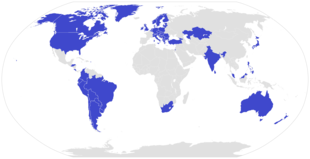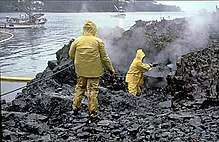ISO 45001
ISO 45001 is an ISO standard for management systems of occupational health and safety (OH&S), published in March 2018. The goal of ISO 45001 is the reduction of occupational injuries and diseases, including promoting and protecting physical and mental health.[1]

The standard is based on OHSAS 18001, conventions and guidelines of the International Labour Organization including ILO OSH 2001, and national standards.[1][2] It includes elements that are additional to BS OHSAS 18001 which it is replacing over a three-year migration period from 2018 to 2021.[3]
ISO 45001 follows the High Level Structure of other ISO standards, such as ISO 9001:2015 and ISO 14001:2015, which makes integration of these standards easier.[4][5]
Development
ISO 45001 was proposed at the ISO in October 2013. The committee ISO/PC 283, created in 2013, had direct responsibility for the standardization process.[6] At least 70 countries contributed to the drafting process.[7] Preparation and committee work lasted until December 2015. From 2015 to 2017, a first draft failed to gain sufficient approval from ISO members and was revised in a second draft, which was approved and refined into a final draft.[6] In the final vote, the standard garnered 62 votes in favour, nine abstentions and four votes against from France, India, Spain, and Turkey.[8] The standard was published on 12 March 2018.[6]
Certification
ISO 45001 is set to replace OHSAS 18001 over three years following its publication in March 2018.[9] BSI will formally withdraw BS OSHAS 18001 in March 2021, at the end of the migration period.[9] ISO 45001 uses the management system standard structure guideline Annex SL to allow for simplified integration with other management system standards, such as ISO 9001 and ISO 14001.[10] The International Accreditation Forum has published requirements for migration from OHSAS 18001 to ISO 45001.[11]
ISO/IEC TS 17021-10:2018 is a technical specification setting out competence requirements for auditing and certification of ISO 45001.[12]
Adoption
ISO 45001 was adopted as a national standard by Albania, Argentina, Austria, Australia, Belgium, Bolivia, Bosnia and Herzegovina, Brazil, Bulgaria, Canada, Chile, Colombia, Costa Rica, Croatia, the Czech Republic, Denmark, Ecuador, El Salvador, Estonia, Finland, Georgia, Germany, Greece, Honduras, Hungary, India, Ireland, Israel, Italy, Japan, Kazakhstan, Latvia, Lithuania, Malaysia, the Netherlands, New Zealand, North Macedonia, Norway, Paraguay, Peru, the Philippines, Poland, Romania, Serbia, Singapore, Slovakia, Slovenia, South Africa, Sri Lanka, Sweden, Switzerland, Turkey, the United Kingdom, the United States, and Uruguay.N-[1]
ISO 45001 changes compared to OHSAS 18001:2007
- Context of the organization (Clause 4.1): The organization shall determine internal and external issues that are relevant to its purpose and that affect its ability to achieve the intended outcome(s) of its OH & S management system.
- Understanding the needs and expectations of workers and other interested parties (clause 4.2): interested parties are workers, suppliers, subcontractors, clients, regulatory authorities.
- Risk and opportunities (Clauses: 6.1.1, 6.1.2.3, 6.1.4): companies are to determine, consider and, where necessary, take action to address any risks or opportunities that may impact (either positively or negatively) the ability of the management system to deliver its intended results, including enhanced health and safety at the workplace.
- Leadership and management commitment (Clauses: 5.1) has stronger emphasis on top management to actively engage and take accountability for the effectiveness of the management system.
- Planning: (clause 6)
See also
- ISO 37001-Anti-bribery management systems
- Safety management systems
Notes
References
- "ISO 45001 Occupational health and safety". www.iso.org. Retrieved 13 March 2018.
- "ILO OSH 2001". www.ilo.org. ILO. Retrieved 25 September 2018.
- "ISO 45001". www.iso.org. ISO official website. Retrieved 25 September 2018.
- International Standards Organisation, ISO. Information brochure - ISO 45001 (1 ed.). Geneva: ISO. Retrieved 25 September 2018.
- "ISO high level structure explained". www.auditortraining.pwc.com.au. PWC (Price waterhouse coopers). Retrieved 25 September 2018.
- "ISO 45001:2018 - Occupational health and safety management systems -- Requirements with guidance for use". www.iso.org. Retrieved 13 March 2018.
- "ISO 45001 is now published". ISO. Retrieved 13 March 2018.
- "La norme ISO 45001 publiée prochainement" (in French). Organisme Professionnel de Prévention du Bâtiment et Travaux Publics. 26 February 2018. Retrieved 9 May 2018.
- "ISO 45001 BS OHSAS 18001 Revision | BSI America". www.bsigroup.com. Retrieved 16 April 2019.
- "Let the migration begin". ISO. Retrieved 13 March 2018.
- "IAF Publications: Mandatory Documents". www.iaf.nu. 1 February 2018. Retrieved 13 March 2018.
- "ISO/IEC TS 17021-10:2018". ISO. Retrieved 9 May 2018.
- "Sistemet e menaxhimit të shëndetit dhe sigurisë në punë- Kërkesat me udhëzime për përdorim". Drejtoria e Përgjithshme e Standardizimit. Retrieved 13 May 2018.
- "Sistemas de gestión de la seguridad y salud en el trabajo. Requisitos con orientación para su uso". Instituto Argentino de Normalización y Certificación. Retrieved 6 May 2018.
- "ISO 45001 - der neue weltweite Standard für Gesundheit und Sicherheit am Arbeitsplatz". 3 July 2018. Retrieved 13 May 2018.
- "AS/NZS ISO 45001:2018". SAI Global Limited. Retrieved 22 December 2018.
- "Veiligheid en gezondheidsmanagementsystemen - Eisen met richtlijnen voor gebruik". Bureau voor Normalisatie. Retrieved 19 March 2018.
- "Sistemas de gestión de la seguridad y salud en el trabajo – Requisitos con orientación para su uso". IBNORCA. Retrieved 28 December 2018.
- "Sistemi upravljanja zdravljem i bezbjednošću na radu - Zahtjevi s uputstvom za korištenje". Institut za standardizaciju Bosne i Hercegovine. 7 June 2019. Retrieved 8 November 2019.
- "Sistemas de gestão de saúde e segurança ocupacional - Requisitos com orientação para uso". Associação Brasileira de Normas Técnicas. Retrieved 13 May 2018.
- "Системи за управление на здравето и безопасността при работа. Изисквания с указания за прилагане". Instituto Argentino de Normalización y Certificación. Retrieved 6 May 2018.
- "Occupational health and safety management systems — Requirements with guidance for use". Standards Council of Canada. 1 March 2019. Retrieved 8 November 2019.
- "Sistemas de gestión de la seguridad y salud en el trabajo - Requisitos con orientación para su uso". Instituto Nacional de Normalización. Archived from the original on 14 May 2018. Retrieved 13 May 2018.
- "Sistemas de gestión de la seguridad y salud en el trabajo. Requisitos con orientación para su uso". ICONTEC Internacional. Retrieved 28 December 2018.
- "Sistemas de gestión de la seguridad y salud en el trabajo - Requisitos con orientación para su uso". Instituto de Normas Técnicas de Costa Rica. Retrieved 13 May 2018.
- "Sustavi upravljanja zaštitom zdravlja i sigurnosti pri radu -- Zahtjevi s uputama za uporabu". Hrvatski zavod za norme. Retrieved 13 May 2018.
- "Systémy managementu bezpečnosti a ochrany zdraví při práci - Požadavky s návodem k použití". Česká agentura pro standardizaci. Retrieved 28 December 2018.
- "Arbejdsmiljøledelsessystemer – Krav og vejledning om brug". Fonden Dansk Standard. Retrieved 19 March 2018.
- "Catálogo de documentos normativos vigentes". Dirección de Normalización. Retrieved 18 February 2019.
- "Catalogo de normas". Organismo Salvadoreño de Normalización. Retrieved 25 February 2019.
- "Töötervishoiu ja tööohutuse juhtimissüsteemid. Nõuded koos kasutusjuhistega". Eesti Standardikeskus. Retrieved 11 May 2018.
- "Työterveys- ja työturvallisuusjärjestelmät. Vaatimukset ja niiden soveltamisohjeita". Suomen Standardisoimisliitto SFS ry. Retrieved 1 May 2018.
- "სსტ ისო 45001:2018". Georgian National Agency for Standards and Metrology. Retrieved 25 February 2019.
- "Managementsysteme für Sicherheit und Gesundheit bei der Arbeit - Anforderungen mit Anleitung zur Anwendung". Beuth Verlag. Retrieved 5 May 2018.
- "Συστήματα διαχείρισης για την υγεία και ασφάλεια στην εργασία - Απαιτήσεις και οδηγίες εφαρμογής". Hellenic Organization for Standardization. Retrieved 18 July 2018.
- "OHN-ISO 45001:2018". Organismo Hondureño de Normalización. Retrieved 25 February 2019.
- "A munkahelyi egészségvédelem és biztonság irányítási rendszere. Követelmények alkalmazási útmutatóval". MSZT. Retrieved 10 June 2018.
- "IS/ISO 45001 : 2018 Occupational Health and Safety Management Systems — Requirements with Guidance for Use". Bureau of Indian Standards. Retrieved 8 November 2019.
- saiglobal.com. "I.S. ISO 45001:2018 | Occupational health and safety managem... | NSAI". shop.standards.ie. Retrieved 26 March 2018.
- "ת"י 45001". Standards Institute of Israel. Retrieved 25 February 2019.
- "Sistemi di gestione per la salute e sicurezza sul lavoro". UNI. Retrieved 19 March 2018.
- "JIS Q 45001:2018". Japanese Standards Association. Retrieved 22 December 2018.
- "Системы менеджмента безопасности труда и охраны здоровья". KAZMEMST. 1 July 2019. Retrieved 8 November 2019.
- "Arodveselības un darba drošības pārvaldības sistēmas. Prasības un lietošanas norādījumi". Latvijas standarts. Retrieved 22 December 2018.
- "Darbuotojų sveikatos ir saugos vadybos sistemos. Reikalavimai ir taikymo nurodymai". Lietuvos standartizacijos departamentas. Retrieved 22 December 2018.
- "MS ISO 45001:2018". Department of Standards Malaysia. Retrieved 22 December 2018.
- "Managementsystemen voor gezond en veilig werken - Eisen met richtlijnen voor gebruik". NEN. Retrieved 19 March 2018.
- "Системи за менаџмент со безбедност и здравје при работа – Барања со упатство за употреба". Институтот за стандардизација на Република Северна Македонија. 30 April 2018. Retrieved 8 November 2019.
- "Ledelsessystemer for arbeidsmiljø - Krav og veiledning om bruk". Standard Norge. Retrieved 13 May 2018.
- "NP-ISO 45001. Sistemas de gestión de la seguridad y salud en el trabajo - Requisitos con orientación para su uso". Instituto Nacional de Tecnología, Normalización y Metrología. Retrieved 18 February 2019.
- "NTP-ISO 45001:2018". Instituto Nacional de Calidad. Retrieved 18 February 2019.
- "DTI approves the adoption of an International Standard on Occupational health and safety management systems as PNS". Bureau of Philippine Standards. Retrieved 25 February 2019.
- "Systemy zarządzania bezpieczeństwem i higieną pracy -- Wymagania i wytyczne stosowania". Polski Komitet Normalizacyjny. Retrieved 18 July 2018.
- "Sisteme de management al sănătăţii şi securităţii în muncă. Cerinţe şi îndrumări pentru utilizare". ASRO. Archived from the original on 22 May 2018. Retrieved 13 May 2018.
- "Sistemi menadžmenta bezbednošću i zdravljem na radu - Zahtevi sa uputstvom za korišćenje". Институт за стандардизацију Србије. Retrieved 21 May 2018.
- "Occupational health and safety management systems — Requirements with guidance for use". Toppan Leefung Pte. Ltd. Archived from the original on 22 May 2018. Retrieved 21 May 2018.
- "Systémy manažérstva bezpečnosti a ochrany zdravia pri práci. Požiadavky s návodom na používanie". Úrad pre normalizáciu, metrológiu a skúšobníctvo SR. Retrieved 28 December 2018.
- "Sistem vodenja varnosti in zdravja pri delu - Zahteve z napotki za uporabo". Slovenski inštitut za standardizacijo. Retrieved 13 May 2018.
- "SANS 45001:2018". South African Bureau of Standards. Retrieved 25 February 2019.
- "Occupational health and safety management systems – requirements with guidance for use". Sri Lanka Standards Institute. Retrieved 8 November 2019.
- "Ledningssystem för arbetsmiljö - Krav och vägledning". SIS. Retrieved 6 May 2018.
- "Occupational health and safety management systems - Requirements with guidance for use". Schweizerische Normen-Vereinigung. Retrieved 6 May 2018.
- "İş sağlığı ve güvenliği yönetim sistemleri - Kullanım için rehberlik gereksinimleri". Türk Standardlari Enstitüsü. Retrieved 10 June 2018.
- "Occupational health and safety management systems". British Standards Institution. Retrieved 19 March 2018.
- "ANSI/ASSP/ISO 45001-2018 Occupational Health and Safety Management Systems - Requirements with Guidance for Use". The American Society of Safety Professionals. Retrieved 18 February 2019.
- "Sistemas de gestión de la seguridad y salud en el trabajo — Requisitos con orientación para su uso". Instituto Uruguayo de Normas Técnicas. Retrieved 13 May 2018.
